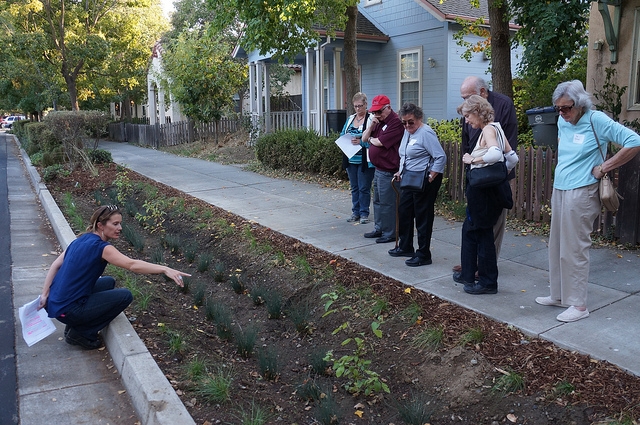Planting a rain garden can help prevent loss of topsoil, increase biodiversity

What is a rain garden?
A rain garden is a sunken area that redirects rain water away from buildings, driveways, lawns and other landscape features, and holds onto that water long enough to filter out 80 percent of the sediment and pollutants. Native plants are typically installed in rain gardens so that additional irrigation is not needed once they are established. These plants help hold, filter and slow the release of rainwater, allowing 30 percent more water to be absorbed. This usually occurs within 48 hours, preventing mosquito breeding.
Why have a rain garden?
If you live South County, you know our occasional rains can be disruptive. Our soils dry to the point of being hydrophobic, repelling water and causing flash floods. You may not have experienced a flash flood in your yard, but these principles can help prevent the loss of topsoil and other problems associated with urban drool. Also, most of the water that comes off roofs and driveways contain pollutants that you probably don't want in your garden. Installing a rain garden also helps attract beneficial insects and other pollinators, increasing biodiversity.
How and where are rain gardens installed?
Since most of the water for your rain garden will probably come from rain gutter downspouts, select a location that allows for a path (read decorative trench) from those downspouts to a low area in your yard. Areas with full sun are preferred over shady areas. Rain gardens should be at least 10 feet from the home or other buildings and not over a septic field. Once you have a location, use these steps to create your rain garden:
1. Calculate size — South County's heavy clay soil requires a drainage area 45 to 60 percent of the size of your roof or driveway — sandy soil only needs 20 percent and loam uses 30 to 35 percent. Any size rain garden can have a positive impact. This may be more space than you have or are willing to dedicate, but it may help you realize why certain areas of your landscape seem plagued with fungal diseases. Since most homes have multiple downspouts, smaller rain garden plots can be created for each downspout.
2. Design the shape — Once you have determined how much area you are dedicating, use a rope or garden hose to lay out the design. This lets you play with different ideas before you start digging. A Google Maps satellite image of your property can also help you select the best location and shape. Consider where any overflow might end up, just in case. Once you have selected a location and shape, contact the local utilities company (call 811) to make sure you won't run into something you shouldn't.
3. Start digging — After you've been cleared and your soil has dried out from all the recent rain, you can start digging. Begin by removing 6 to 8 inches of soil from the rain garden site, sloping downward away from the trench. Next, dig the trench. The trench will need to slope for the water to go where you want it. The trench can be covered, like a French drain, or it can be filled with decorative river rocks. Finally, amend the planting area by digging in 2 or 3 inches of aged compost.
4. Select the plants — Native grasses and flowers are the best choice for a rain garden. They have already evolved to handle south county rain, temperatures, and soil. U.C. Davis Arboretum All Stars, the CA Native Plant Society's Plant Lists, and your local Master Gardeners are always available for plant selection advice.
5. Install the plants — While still in their pots, try placing plants in various locations to see what looks the best, keeping mature sizes in mind. Grouping plants in odd numbers often looks the best, but leave at least one foot between each plant. Once you have the layout you want, put your new plants in the ground using a hand trowel.
6. Mulch and water — Contact a local tree trimming company for coarsely shredded wood chips. This highly useful mulch is almost always free, just make sure that it is disease- and palm-free. Apply a 2 to 3 inches layer to keep down weeds and make it look nice. Water the area every other day for the first couple of weeks, unless it rains, until your new plants are established. They may need additional watering during their first summer, but that should be about it.
This is a big project, but it is one that will improve soil and water quality in your South Valley home's landscape for a very long time.
You can learn more about garden design at the South County Teaching and Demo Garden at St. Louise Hospital, 9400 No Name Uno Way, Gilroy. Classes are regularly offered to the public. For more information, check our events page or call (408) 282-3105 between 9:30 a.m. and 12:30 p.m., Monday through Friday.
by UC Master Gardener Kate Russell
Photo: Stacey Parker, UC Davis Arboretum and Public Garden GATEways horticulturist, points out the new rain garden feature of the Davis Commons Shopping Center parking lot. Guests learn how the feature will improve stormwater management.
This article first appeared in the March 29 to April 11 issue of Morgan Hill Life.

